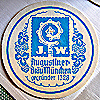 One of the delights of Munich.
One of the delights of Munich.Perhaps it was Bavaria’s famous, free-floating Gemütlichkeit or just the excellent jazz ensemble from a nearby town, but the opening plenary at the Munich Satellite Navigation Summit this evening (March 1) was awash in benign goodwill but little new insight into the condition of the world’s GNSS systems.
Perhaps it was Bavaria’s famous, free-floating Gemütlichkeit or just the excellent jazz ensemble from a nearby town, but the opening plenary at the Munich Satellite Navigation Summit this evening (March 1) was awash in benign goodwill but little new insight into the condition of the world’s GNSS systems.
Paul Weissenberg, the European Commission (EC’s) newly minted Enterprise and Industry deputy director-general for space, security, and a wide swath of other economic segments revealed that EC Vice-President Antonio Tajani would declare the EGNOS safety-of-life service operational tomorrow (March 2).
Otherwise, after declaring his sense of a “certain commitment from all GNSS countries to cooperate more . . . even our friends in China,” he neatly dodged a question as to whether his recent trip to that country had produced a way out from the yearslong impasse involving the Compass/BeiDou-2 overlay of the Galileo publicly regulated service (PRS). (Later conversations at the post-plenary reception suggested that a higher level diplomatic initiative may move the issue along.)
The most provocative — or perhaps evocative — comment came from Bavarian Economic Affairs Minister Martin Zeil in the midst of his hearty willkommen address. Little more than 50 years after the launch of the first satellite (the Soviet Union’s Sputnik 1), he said, “the excitement about satellites has died down.”
Indeed, popular sentiments about GNSS — better known in the public mind as location — have little to do with satellites, signals, or spectrum and everything to do with “Can I get in here and now?”
A solid Summit program over the next two days may provide more refined — and substantive — views on these and other subjects.

